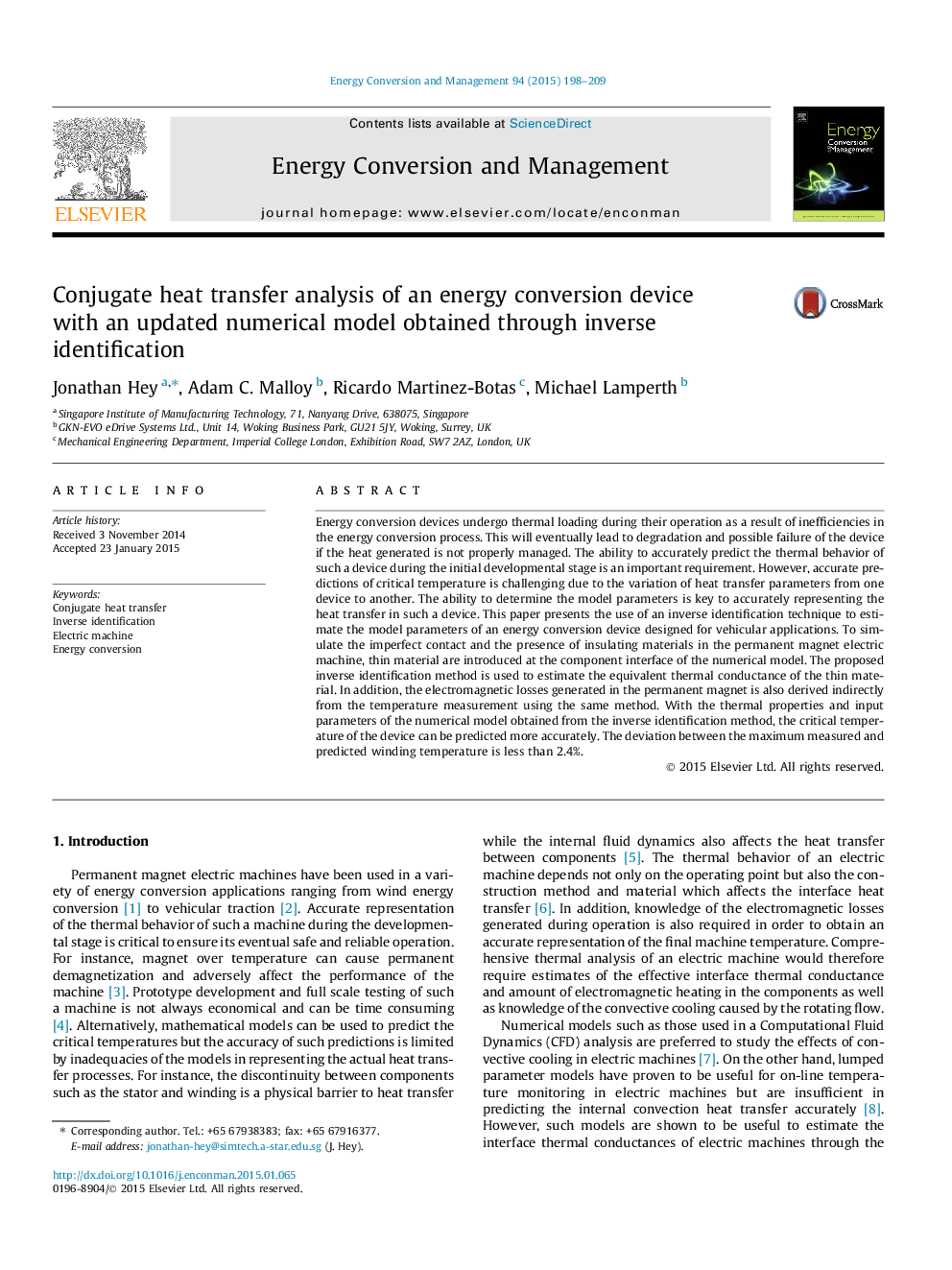| کد مقاله | کد نشریه | سال انتشار | مقاله انگلیسی | نسخه تمام متن |
|---|---|---|---|---|
| 7162801 | 1462868 | 2015 | 12 صفحه PDF | دانلود رایگان |
عنوان انگلیسی مقاله ISI
Conjugate heat transfer analysis of an energy conversion device with an updated numerical model obtained through inverse identification
ترجمه فارسی عنوان
تجزیه و تحویل انتقال حرارت کنجد یک دستگاه تبدیل انرژی با یک مدل عددی به روز شده به دست آمده از طریق شناسایی معکوس
دانلود مقاله + سفارش ترجمه
دانلود مقاله ISI انگلیسی
رایگان برای ایرانیان
کلمات کلیدی
انتقال حرارت متصل، شناسایی معکوس، ماشین الکتریکی، تبدیل انرژی،
ترجمه چکیده
دستگاه های تبدیل انرژی تحت بارگذاری حرارتی در طول عملیات خود، به دلیل ناکارایی در روند تبدیل انرژی، بارگیری می شوند. اگر حرارت تولید شده به درستی مدیریت نشود، در نهایت منجر به تخریب و شکست احتمالی دستگاه خواهد شد. توانایی پیش بینی دقیق حرارتی چنین دستگاهی در مرحله اولیه تکاملی، یک نیاز مهم است. با این حال، پیش بینی دقیق دمای بحرانی به دلیل تنوع پارامترهای انتقال حرارت از یک دستگاه به یک دیگر چالش برانگیز است. توانایی تعیین پارامترهای مدل، کلید دقیق انتقال حرارت در چنین دستگاهی است. در این مقاله استفاده از تکنیک شناسایی معکوس برای برآورد پارامترهای مدل یک دستگاه تبدیل انرژی طراحی شده برای کاربردهای وسیله نقلیه ارائه شده است. برای شبیه سازی تماس نامناسب و حضور مواد عایق در ماشین الکتریکی مغناطیسی دائمی، مواد نازک در رابط مولفه مدل عددی معرفی می شوند. روش پیشنهادی معکوس پیشنهادی برای تخمین هدایت حرارت معادل مواد نازک استفاده می شود. علاوه بر این، تلفات الکترومغناطیسی تولید شده در آهنربای دائمی نیز به طور غیرمستقیم از اندازه گیری دما با استفاده از روش مشابه حاصل می شود. با خواص حرارتی و پارامترهای ورودی مدل عددی به دست آمده از روش شناسایی معکوس، دمای بحرانی دستگاه را می توان با دقت بیشتری پیش بینی کرد. انحراف بین حداکثر اندازه گیری و پیش بینی سیم پیچ کمتر از 2.4٪ است.
موضوعات مرتبط
مهندسی و علوم پایه
مهندسی انرژی
انرژی (عمومی)
چکیده انگلیسی
Energy conversion devices undergo thermal loading during their operation as a result of inefficiencies in the energy conversion process. This will eventually lead to degradation and possible failure of the device if the heat generated is not properly managed. The ability to accurately predict the thermal behavior of such a device during the initial developmental stage is an important requirement. However, accurate predictions of critical temperature is challenging due to the variation of heat transfer parameters from one device to another. The ability to determine the model parameters is key to accurately representing the heat transfer in such a device. This paper presents the use of an inverse identification technique to estimate the model parameters of an energy conversion device designed for vehicular applications. To simulate the imperfect contact and the presence of insulating materials in the permanent magnet electric machine, thin material are introduced at the component interface of the numerical model. The proposed inverse identification method is used to estimate the equivalent thermal conductance of the thin material. In addition, the electromagnetic losses generated in the permanent magnet is also derived indirectly from the temperature measurement using the same method. With the thermal properties and input parameters of the numerical model obtained from the inverse identification method, the critical temperature of the device can be predicted more accurately. The deviation between the maximum measured and predicted winding temperature is less than 2.4%.
ناشر
Database: Elsevier - ScienceDirect (ساینس دایرکت)
Journal: Energy Conversion and Management - Volume 94, April 2015, Pages 198-209
Journal: Energy Conversion and Management - Volume 94, April 2015, Pages 198-209
نویسندگان
Jonathan Hey, Adam C. Malloy, Ricardo Martinez-Botas, Michael Lamperth,
